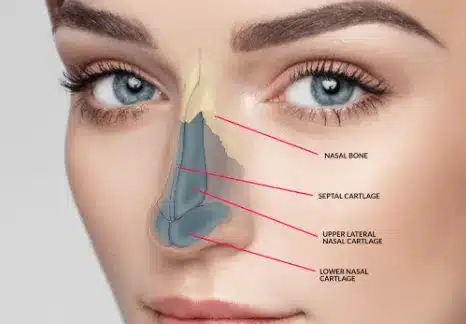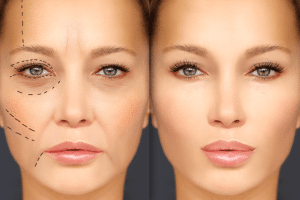Understanding the cost of a nose job, or rhinoplasty, involves considering various factors such as surgical fees and the surgeon’s fee. Rhinoplasty cost encompasses expenses beyond the surgeon’s fee, including anesthesia, facility charges, and pre-operative and post-operative expenses. By delving into these aspects, patients can gain clarity on the overall nose job expense and make informed decisions regarding their surgical investment.
20 factors from the cost of a nose job
Like any surgical procedure, the cost of a nose job can vary depending on several factors. Here are 20 factors that can influence the cost of a nose job:
- Geographic location: The cost of living and healthcare expenses vary from one location to another, resulting in different pricing for nose jobs.
- Surgeon’s experience and reputation: Highly experienced and reputable plastic surgeons typically charge higher fees for their expertise and skill.
- Surgical facility: The type of facility where the procedure is performed can impact the cost. Hospitals or accredited surgical centers may charge more compared to outpatient clinics.
- The complexity of the procedure: The complexity of the surgery, such as addressing functional issues or performing extensive structural changes, can affect the cost.
- Primary or revision rhinoplasty: A primary nose job, performed for the first time, may have a different cost than a revision rhinoplasty, which involves correcting previous surgical outcomes.
- Open or closed rhinoplasty: The surgical approach used, either an open or closed technique, can influence the cost. Open rhinoplasty, which involves an external incision, may be more expensive due to its complexity.
- Desired changes: The extent of changes desired, whether it involves refining the tip, reducing the size, correcting asymmetry, or altering the overall shape, can impact the cost.
- Anesthesia fees: The cost of anesthesia administered during the surgery, which ensures patient comfort, will be factored into the overall cost.
- Pre- and post-operative care: Consultations, medical tests, and follow-up appointments before and after the surgery may have separate charges or be included in the overall cost.
- Consultation fees: Some surgeons may charge a consultation fee to assess the patient’s needs and determine the best approach for their nose job.
- Surgeon’s fees: The surgeon’s professional fees for performing the procedure are a significant component of the total cost.
- Facility fees: The charges associated with the use of the surgical facility, including operating room fees and related services, are included in the overall cost.
- Anesthesiologist fees: If an anesthesiologist administers the anesthesia, their professional fees will be separate.
- Medical tests and imaging: Preoperative tests, such as blood work, X-rays, or CT scans, may be required and can contribute to the total cost.
- Medications: The cost of prescribed medications, such as painkillers or antibiotics, will be an additional expense.
- Surgical garments: Postoperative garments or splints that help heal and maintain the results may have associated costs.
- Complications or revisions: In case of complications or the need for revisions, additional procedures or treatments may be necessary, leading to increased costs.
- Surgeon’s reputation: Surgeons with a higher demand due to their reputation or popularity may charge higher fees.
- Insurance coverage: In some cases, if the nose job is performed for functional reasons rather than purely cosmetic, a portion of the cost may be covered by insurance.
- Market competition: The market’s competitive nature can influence pricing, with some surgeons offering competitive rates or discounts to attract patients.
Generally, rhinoplasty is considered a cosmetic procedure, and the cost is typically not covered by health insurance
n searching for a plastic surgeon to perform rhinoplasty, it’s important to find an experienced surgeon who offers realistic prices and natural results. The William Center
It’s important to note that the abovementioned costs are general considerations, and the actual cost of a nose job can vary widely depending on these factors. Consulting with a qualified plastic surgeon is crucial to obtain an accurate estimate based on your needs and circumstances.
The desire to enhance one’s appearance is a common pursuit, and for those with a fleshy nose, a nose job can be a transformative solution. A fleshy nose, characterized by its larger size and excess soft tissue, may cause individuals to feel self-conscious or dissatisfied with their facial harmony.
Clinic contact number: +989371200167
Analyzing Costs and Trends in Nose Job Procedures
In the realm of rhinoplasty cost analysis, prominent figures like Dr. Rod Rohrich from the University of Texas Southwestern Medical Center and Dr. Dean Toriumi from the University of Illinois College of Medicine have made significant contributions. Their expertise in facial plastic surgery and research on cost-effectiveness in rhinoplasty procedures have helped shape the understanding of financial aspects within the field. Additionally, hospitals like the Cleveland Clinic and companies like Allergan have been at the forefront of providing comprehensive services related to rhinoplasty, including cost analysis consultations and financial planning assistance.
Recent statistics reveal intriguing trends in rhinoplasty costs. According to data from the American Society of Plastic Surgeons, the average cost of rhinoplasty procedures has seen a gradual increase over recent years, with variations based on geographic location, surgeon experience, and the complexity of the procedure. This upward trajectory in rhinoplasty costs reflects advancements in surgical techniques, an increased demand for cosmetic procedures, and the incorporation of innovative technologies, all contributing to the overall expense associated with nose jobs.
Such statistics underscore the importance of thorough financial planning and consultation with qualified professionals to ensure patients have a clear understanding of the costs involved in achieving their desired aesthetic goals.
Is a nose job expensive surgery?
Generally, rhinoplasty is considered a cosmetic procedure, and health insurance typically does not cover the cost unless there is a medical necessity.
On average, a nose job can range from a few thousand dollars to tens of thousands of dollars. In some cases, the cost may exceed $10,000 or more. It’s essential to consult with a qualified plastic surgeon to discuss your specific goals and receive an accurate cost estimate. Remember that cost should not be the determining factor when considering a nose job.
Nose job, a common term for rhinoplasty, is a transformative nasal surgery that falls under the umbrella of both cosmetic and plastic surgery. Tailored to address diverse nasal types, including bulbous, Roman, and crooked noses, rhinoplasty offers individuals the opportunity to enhance both the aesthetic appearance and functional aspects of their nose. By utilizing advanced surgical techniques and personalized approaches, rhinoplasty can achieve harmonious nasal symmetry and contouring, ultimately empowering patients to achieve their desired facial aesthetics.
Value for money
Value for money in the context of a nose job, or rhinoplasty, refers to the balance between the cost of the procedure and the quality of the results achieved. While the cost of a nose job can vary depending on factors such as the surgeon’s experience, geographic location, and the complexity of the procedure, patients should consider the overall value they receive in return for their investment. Factors that contribute to value for money include:
- Quality of care: Patients should seek out a board-certified plastic surgeon with extensive experience in performing rhinoplasty procedures. The quality of care provided by the surgeon and their support team, as well as the reputation of the surgical facility, are important considerations in determining value for money.
- Results achieved: The primary goal of a nose job is to achieve desired aesthetic outcomes while maintaining or improving nasal function. Patients should assess the results achieved by the surgeon in past procedures and ensure that their expectations align with the potential outcomes of the surgery.
- Long-term satisfaction: Value for money extends beyond the immediate cost of the procedure to encompass long-term satisfaction with the results. Patients should consider factors such as the durability and longevity of the results achieved, as well as the likelihood of needing revision surgery in the future.
- Comprehensive care: Patients should inquire about the extent of post-operative care provided by the surgeon and their team, including follow-up appointments, access to resources for managing recovery, and support in addressing any concerns or complications that may arise.
Ultimately, value for money in a nose job involves striking a balance between cost and quality to ensure that patients receive the best possible outcomes and overall experience from their surgical investment.
Clinic contact number: +989371200167
Hidden costs of a Nose job
It’s important for patients considering a nose job to discuss potential hidden costs with their surgeon and carefully review the financial aspects of the procedure to ensure they are fully informed and prepared for any additional expenses that may arise.
Revision surgeries
In some cases, additional procedures or revisions may be necessary to achieve the desired results or address complications, which can incur extra expenses.
Post-operative care and medications
While some post-operative care and medications may be included in the initial cost estimate, unforeseen complications or prolonged recovery may require additional treatments or prescriptions.
Pain medication
Prescribed pain medication helps manage any discomfort or pain experienced during the initial days after surgery. The cost of these medications can vary depending on the type and dosage prescribed.
Antibiotics
Antibiotics may be prescribed to reduce the risk of infection following surgery. The cost of antibiotics can vary depending on the specific medication prescribed and the duration of treatment.
Steroid medication
Steroids may be prescribed to help reduce swelling and inflammation in the nasal tissues following surgery. The cost of steroid medication can vary depending on the type and dosage prescribed.
Anesthesia fees
While anesthesia fees are typically included in the overall cost estimate, unexpected changes in anesthesia requirements during surgery or extended procedure times may result in additional charges.
Clinic contact number: +989371200167
Summary
In conclusion, while considering the cost of a nose job, or rhinoplasty, it’s crucial to evaluate not only the initial surgical fees but also potential hidden costs and the quality of care provided. Rhinoplasty cost encompasses various expenses, including surgical fees, anesthesia, facility charges, and post-operative care, all of which contribute to the overall nose job expense. Additionally, patients should be mindful of potential hidden costs, such as revision surgery costs or unforeseen complications, and factor these into their financial planning.
Ultimately, prioritizing the quality of care and expertise of the surgeon is paramount, as it directly impacts the safety and success of the procedure, ensuring that patients receive the best possible outcomes and value for their investment in a nose job.

FAQs:
- What is the average cost of a nose job?
The average cost of a nose job, or rhinoplasty, can vary widely but generally ranges from several thousand to tens of thousands.
2. Will insurance cover the cost of a nose job?
In most cases, insurance companies do not cover the cost of a nose job as it is typically considered a cosmetic procedure. However, if the surgery is performed to address functional issues, insurance may cover a portion of the cost.
3. How long is the recovery time for a nose job?
The recovery time for a nose job varies from person to person, but generally, it can take several weeks to months for swelling and bruising to subside and for the final results to become fully apparent.
4. Does insurance cover the cost of a nose job?
In most cases, insurance does not cover the cost of a nose job if it is performed for cosmetic reasons. However, if the rhinoplasty is deemed medically necessary to address functional issues such as breathing difficulties or nasal deformities caused by injury or congenital conditions, insurance may cover a portion of the expenses. It’s important to check with your insurance provider to understand your coverage options.
5. What financing options are available for a nose job?
Many plastic surgery practices offer financing options to help patients cover the cost of a nose job. These may include payment plans, medical credit cards, or financing through third-party providers. Patients should inquire about financing options during their initial consultation with the surgeon.
How Much Does Rhinoplasty Surgery Cost? | Williams Center Williams Center (williamsfacialsurgery.com)




